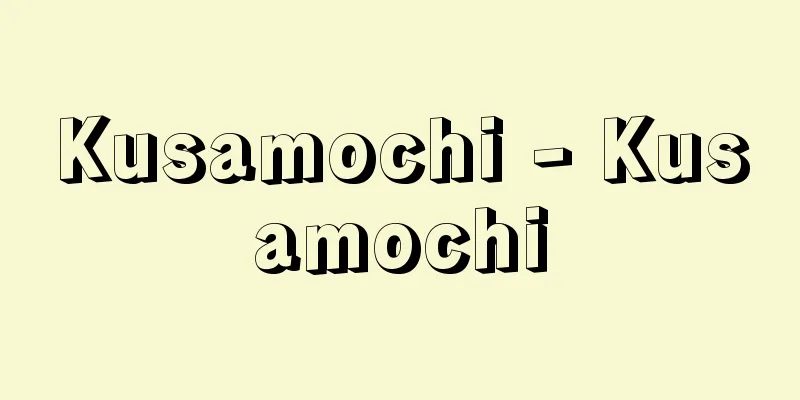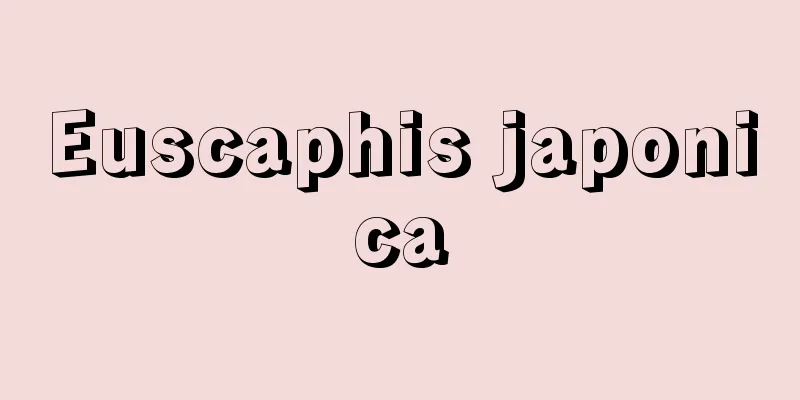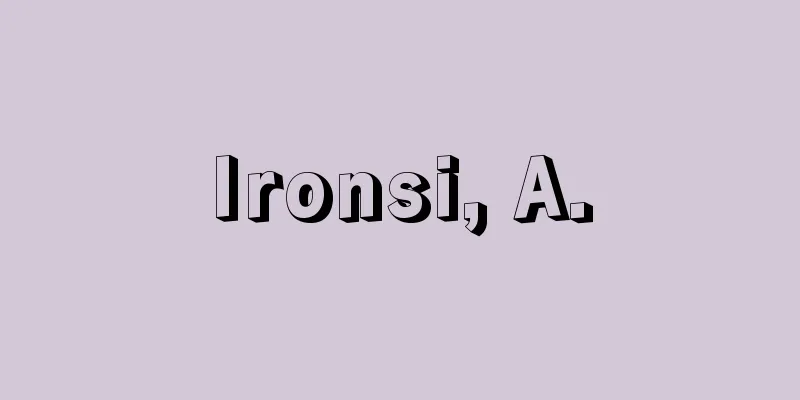Kusamochi - Kusamochi

|
A type of mochi confectionery. Mochi made with ingredients such as chickweed and mugwort. In the Heian period, the Montoku Jitsuroku (Chronicles of Emperor Montoku) records in 850 (Kasho 3) that on March 3rd, women and children would gather chickweed, steam it, and pound it into mochi. The Chinese 6th century Keiso Saijiki (Records of the Years of Jingchu) states that on March 3rd, the juice of chickweed (Chinese name: mouse koji cabbage) is mixed with honey and mixed into flour, and eating this is said to ward off evil spirits and protect against epidemics. It is believed that mugwort began to be used instead of chickweed during the Muromachi period, and the shogunate would bestow mugwort mochi and cups on this day to feudal lords who met with the shogun. In the early Edo period, paper dolls were lined up on a felt mat and decorated with a palanquin, folding screen, sake cup, and portable vessel in a picture cabinet containing mugwort mochi. However, towards the end of the Edo period, the picture cabinet fell out of use and diamond-shaped mochi began to be displayed on a diamond-shaped stand. Diamond-shaped mochi were decorated in three or five layers with mugwort mochi at the center and other colors such as white, blue, and red, or white, blue, and yellow. The significance of kusamochi in the event is so great that March 3rd is also known as the Kusamochi Festival. Kusamochi and kusadango are famous souvenirs from temple towns all over the country because they are considered lucky charms that ward off evil spirits, but generally, kusamochi made with bean paste or kinako mochi has been enjoyed as a rice cake that conveys a bitter taste and the aroma of spring. There are two ways to make kusamochi. One is made by pounding steamed glutinous rice and mugwort into mochi, which is mainly used for kirimochi (cut mochi), and hishimochi (diamond-shaped mochi) is also made this way. The other is made by kneading non-glutinous rice flour, steaming it, mixing it with separately boiled and finely chopped mugwort, and pounding it into a mochi, which is used for bean paste mochi and the like. In the past, it was called mugwort mochi in Kyoto and Osaka, and kusamochi in the Kanto region. [Fumio Sawa] [Reference] |Kirimochi is made by mixing steamed glutinous rice and mugwort ©Shogakukan "> Mugwort rice cake Source: Shogakukan Encyclopedia Nipponica About Encyclopedia Nipponica Information | Legend |
|
餅菓子の一種。ハハコグサやヨモギなどを入れて搗(つ)いた餅。平安時代には3月3日に婦女子がハハコグサを採取して蒸し、餅に搗き込んだことが『文徳実録(もんとくじつろく)』の850年(嘉祥3)に記されている。6世紀に著された中国の『荊楚歳時記(けいそさいじき)』には、3月3日にハハコグサ(漢名は鼠麹菜(そきくさい))の汁を蜜(みつ)とあわせ粉に和するとあり、これを食すれば邪気を払い、疫病にかからないとされた。ハハコグサのかわりにヨモギを用いるようになったのは室町時代からとみられ、幕府は、将軍に対面する諸侯に、この日よもぎ餅と杯を下賜している。また江戸時代初期の雛(ひな)遊びには、毛氈(もうせん)などの上に紙雛を並べ、駕籠(かご)、屏風(びょうぶ)、銚子(ちょうし)、行器(ほかい)とともによもぎ餅を入れた絵櫃(えびつ)を飾ったが、幕末近くなると絵櫃は廃れ、菱台(ひしだい)に菱餅を飾るようになった。菱餅は、よもぎ餅を中心に白・青・紅、白・青・黄などが三重あるいは五重に飾られた。3月3日を草餅の節供ともいうほど、行事における草餅の意義は大きい。各地の門前町の名物土産に草餅、草団子があるのも、邪気を払う縁起物だからであるが、一般的にはほろ苦みと春の香気を伝える餅菓子として餡(あん)餅やきな粉餅にした草餅が賞味されてきた。 草餅の製法には2通りある。一つは、蒸した糯米(もちごめ)とヨモギを搗き混ぜて餅としたもので、主として切り餅に供され、菱餅もこの製法による。もう一つは、粳(うるち)米粉をこねて蒸し、別にゆでて細かく刻んだヨモギを混ぜ、搗き上げたもので、餡餅などに用いる。昔は京坂でよもぎ餅、関東で草餅と称した。 [沢 史生] [参照項目] |蒸した糯米とヨモギを搗き混ぜてつくられた切り餅©Shogakukan"> よもぎ餅 出典 小学館 日本大百科全書(ニッポニカ)日本大百科全書(ニッポニカ)について 情報 | 凡例 |
>>: Grass Labyrinth - Kusameikyu
Recommend
Union Jack
… [Origin of the national flag] Here we will disc...
yippie
...As a result, hippies gradually became a symbol...
Shishakli, A.
During the French Mandate, he was a leader of the...
Galago - Galago (English spelling)
A general term for animals belonging to the subfa...
Allport, GW - Allport
… Compared to German personality theory, which ha...
Kanze Saburo (Motoshige)
...He was commonly known as Saburo, and his real ...
Foreign tax credit - foreign tax credit
<br /> To adjust for double taxation both in...
Steward, Julian H(aynes)
Born January 31, 1902 in Washington, DC, USA [Died...
Republic of the Marshall Islands - Marshall Islands (English spelling)
Official name: Republic of the Marshall IslandsAre...
Wheel loader
...Some small loaders used in mine tunnels run on...
Consus (English spelling)
An ancient Roman god. He was the patron deity of g...
Gong County Caves - Gong County Caves
This Northern Wei cave temple is located about 1....
Manasseh ben Israel
1604‐57 A Jewish rabbi in the era of mercantilism....
Amagi Tunnel - Amagi Tunnel
...The Amagi Pass is called the Seven Ri Toge Pas...
Ivy [Hot Spring] - Ivy
A hot spring located in the southeastern foot of M...









